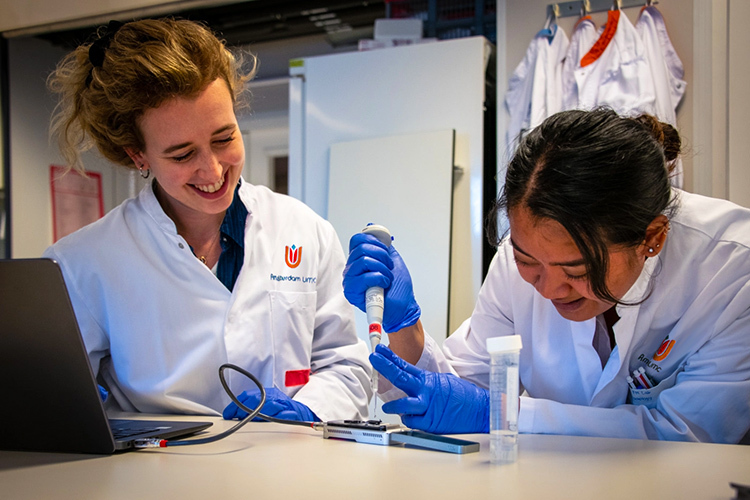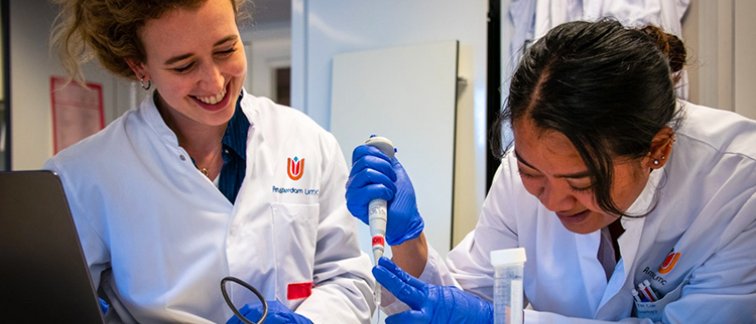methods to detect cancer signals in liquid biopsies (blood or urine samples) can take up to two weeks. A Cancer Center Amsterdam research study led by Florent Mouliere and Norbert Moldovan report that Nanopore sequencing can slash the turnaround time to less than 24 hours, without a loss of sensitivity. The team also demonstrated for the first time that the technique enhanced the analysis of longer DNA fragments originating from tumors. This rapid delivery of results could improve the monitoring of treatment response
and earlier cancer detection in the future.
Nanopore sequencing is a revolutionary DNA sequencing technology that can read the genetic code of DNA molecules with high accuracy and in real-time. It works by “pushing” a single DNA molecule through a tiny channel – a nanopore – embedded in a membrane. As the DNA strand moves through the nanopore, it causes a disruption in the electrical current flowing through the pore that is highly characteristic of the specific DNA bases (A, C, G, T). The signals are recorded and converted into digital data that is analyzed by computer algorithms to determine the sequence of DNA bases, effectively "reading" the genetic code.
The Quest for Sensitivity
A Cancer Center Amsterdam research team led by Florent Mouliere conducted an investigation to see if Nanopore sequencing can improve the detection of cancer signals in blood and urine. “DNA from cancer cells is shed into the blood and urine of cancer patients in the form of cancer-specific ‘cell free’ DNA, or cfDNA,” explains Ymke van der Pol, first author and former PhD student in the groups of Michiel Pegtel and Florent Mouliere. “We wondered, can Nanopore sequencing provide similar – or better - sensitivity and speed compared to conventional sequencing methods for detecting these tumor-derived cfDNA in blood and urine liquid biopsies?”
Speeding Up the Process
Conventional sequencing technologies have, in general, a turnover time of more than 2 weeks before the results become available, potentially causing delays in patient care. Moreover, it is biased towards the detection of short cfDNA fragments. To see if Nanopore sequencing could do better, the team tested the technique on a sequencing platform from Oxford Nanopore Technologies (ONT) using blood plasma collected from 22 lung cancer patients and 3 healthy controls, as well as urine from 8 bladder cancer patients and 2 healthy controls.
“We found that long-read Nanopore sequencing can reduce the turnover time to less than 24 hours,” says Norbert Moldovan, a computation biologist in the Department of Pathology, Cancer Center Amsterdam. “The detection accuracy was similar to conventional technologies for the analysis of copy number aberrations, tumor fraction, and structural properties, like fragmentation patterns.”
Norbert also notes the ONT sequencing platform MinION is highly deployable and has a much lower starting investment cost. “The portability of this technology is remarkable. It’s about the size of a big USB stick, rather than the large fridge size used by conventional sequencing machines. This increases its applicability by making it broadly accessible.” (See photo below.)
Opening a New Window
Additionally, a high proportion of “long” tumor-derived cfDNA fragments (> 300 bp) were recovered in plasma and urine using the ONT sequencing platform. The team was able to demonstrate – for the first time – that tumor-derived cfDNA is abundant among the longer cfDNA fragments.
“That’s very important,” says Florent Mouliere , currently team leader at the Cancer Research UK Cancer Biomarker Centre, University of Manchester and assistant professor at Amsterdam UMC. “The investigation of long cfDNA molecules has been very limited because short-read sequencing technologies were not very efficient at reading long DNA fragments. But the ONT platform approach opens a new window into exploring the biology and structure of long cfDNA fragments. We think there is a lot of untapped potential here. For example, long tumor-derived cfDNAs could contain signals that can be exploited for early cancer detection, like repeat expansions, phased variants, or complex genomic translocations. These are hidden using more conventional sequencing technologies.”
A Brighter Future for Cancer Detection
The reduced turnaround time made possible by Nanopore sequencing holds the potential to transform the way treatment responses are monitored and usher in new, early cancer detection methods. The team plans to confirm the results in larger cohorts with an eye on application in clinical situations involving high-intensity sampling.

Loading a sample into the sequencing platform from Oxford Nanopore Technologies. First authors Ymke van der Pol (left) and Normastuti Adhini Tantyo (right).
For more information contact Florent Mouliere and visit his group’s website, or read the scientific publication:
Ymke van der Pol, Normastuti Adhini Tantyo, et al. (2023) Real-time analysis of the cancer genome and fragmentome from plasma and urine cell-free DNA using nanopore sequencing. EMBO Mol Med (2023) e17282. https://doi.org/10.15252/emmm.202217282
For an earlier report on the Nanopore sequencing speeding up glioma analysis, see: From Weeks to Minutes: Ultrafast Brain Tumor Diagnosis During Surgery
All authors were affiliated with Amsterdam UMC
Lead authors:
Ymke van der Pol,
Normastuti Adhini Tantyo,
Senior authors:
Norbert Moldovan,
Florent Mouliere (now based at the CRUK Manchester Institute)
Collaborators:
Research group of Idris Bahce,
Research group of Renske Steenbergen,
Research group of Michiel Pegtel
Funding

Florent Mouliere received a grant from KWF funding part of this project.
The work received the financial and logistical support from the Liquid Biopsy Centre of Amsterdam UMC.
Information provided by Norbert Moldovan, text by Laura Roy.
This article was created for Cancer Center Amsterdam.
Follow Cancer Center Amsterdam on LinkedIn & Twitter / X.
© 2023 New Haven Biosciences Consulting– All rights reserved.

